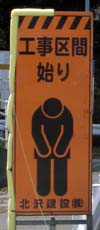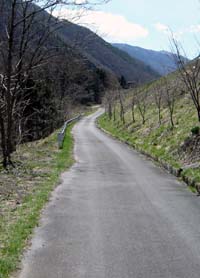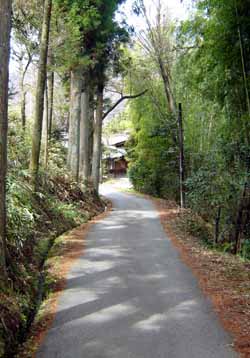Bio
Bicycling Asia
My Other Sites
Suwa to Kiso Valley
April 14, 2007
Distance: 93 km
Top Speed: 72 kph
Time: 11 hrs
Mood: Cold
Kiso Valley is one of the most beautiful escapes in Japan. It is far too narrow and remote to ever have allowed for any real development, so some of the old Edo period towns have been preserved almost as open air museums. The beauty of it is that they are actually just normal working towns for the locals. All the houses are real, and many have been tastefully adapted to allow a garage on the first floor that no one would know about unless the door was left open (as it obviously was). This was a highlight of my whole 2+ years in Japan, and may have been the best "Japanese experience" I've had so far (not that I don't hope to top it repeatedly).

Saturday morning Chris and I woke up a little earlier so he could get to work and I could get a start before 10:00. I shot out of town and was climbing the mountains within 30 minutes. I had loads of energy after a well balanced convenience store breakfast and I got an email from my mom reminding me to find a local drink with electrolytes. That would be the suspiciously names Pocari Sweat, of which I had plenty. I was flying up the mountains, and before another hour was up I was cruising back down the other side drafting trucks all the way down. I hit a little wind in the Matsumoto valley but a couple kilometers before I headed back into the mountains I was battling a strong wind that was having me walk my bike at times! It was the cold air falling off the Japan Alps ahead of me. The air also brought plenty of snow that melted into rain by the time it reached me. It was a strange experience to have clear blue sky's but rain falling everywhere for about an 2 hours. I'll admit it took me a while to figure it out. I was a little wary at first that it could be volcanic gas from the active volcano ahead.


The road began to suck as soon as I entered the Kiso Valley. The valley is narrow, so the road is narrow. But this is a major road, and the only one that goes anywhere in this area, so of course it's also a major truck route. I popped off and on as often as my GPS and intuition told me I could, and then I discovered my first post town. It was listed in Lonely Planet as the least touristy town, but I think Narai would be more adequately labeled, "practically unknown". Only when I left did a tour but show up and unload all its day-trippers at the south end of town. I was grinning from ear to ear. I must have looked like a total dope, but I couldn't help it. It was the cutest little town. I wanted to put it in my pocket and pet it!
The doors were all a meter too short, a step up, and made of paper. The architecture was all brown wood, and probably didn't use a single nail. Every building had a tiny second story balcony that no one could possibly use, but that some old grandmother probably stuck her head out of on occasion nonetheless. The shops were a mixture of local nihon shu (Japanese alcohols like sake, and sho chu) shops, local food makers, local food shops, a sake distillery, tourist wares, and the usual necessary shops (hardware, convenience, post office, etc). It was just one street but all the tiny alleyways between buildings were well cared for, and most had a bamboo stream of water traveling down it to a constantly flowing fountain well at the street side. I learned later that this was a defining characteristic of old post towns in Kiso Valley. This route was the old samurai route from Kyoto to Tokyo and I guess whenever the weather got bad, or a family just couldn't keep up or go any further, they tried to established themselves wherever there was water. There was SO much water in these towns. It was running through bamboo shoots all over the place. It ran under the streets, and turned water wheels for mill work or rice paste. Each house had a wood doorstep that could be lifted up to reveal a constantly flowing tamed river of fresh water. It was amazing.
After Narai there is a 2 kilometer-long tunnel I was not looking forward to. I had hitch-hiked through the last 3 km tunnel and it seemed to take forever, even in a car. I couldn't see the light on the other end, it was slightly up hill, and there was LESS than no shoulder. But there was a workman's sidewalk. It had access to all the power supplies, and panic buttons, and such. It was absolutely a wash of glass and broken car parts, and I couldn't really see it that well. There were lots of puddles, and holes that suspiciously-non-water drips had formed in the concrete! I was not happy, but all I REALLY wanted was to avoid a flat tire. It's only been a few days, and I don't want to jinx myself, but... none yet. The especially stupid thing I decided was to start my trip without any backup tubes. I further proved my idiocy by mailing home my 2 spare tires to save weight, and have STILL chosen crossing my fingers over just finding a bike shop and buying a lousy $5 tube.
I do have patches...
I made it out of the tunnel, and it was a long coast down to Kisofukeshima, the next old post town. On the way I made sure to detour as much as possible through the minor towns along the way. After the last town before Kisofukeshima I got a glimpse of the 2nd tallest mountain in Japan (Mt Fuji is the tallest), and all the amazing snow-capped peaks surrounding it. Actually, they were all damn big, so I'm not sure which one it was, but my map said it was there somewhere...
Kisofukeshima is the most built-up town, but that doesn't say much. It does have a hospital, and a good supermarket, and more than 1 street. But it's still just a small town - limited by the mountains on either side rising up to those very snowy peaks. The old part is relegated to a hilltop in the center of town. It wasn't nearly as nice, or cute as Narai, but it was still very nice, and old. It has one of the most famous soba shops in Japan, but it looked like the kind of place that would gladly charge a price for its namesake, so I skipped it in favor of a self-catered dinner from the supermarket. It was a wicked protein dinner of raw fish, cooked fish, and sausages. It powered me through the rest of the long night of truck drafting and Pocari Sweat breaks. The traffic had thinned a lot, and when my rear lights are all on it seems no one pushes me (knock on wood), so I got back on the main highway and just kept it in high gear. It was a starry night, and I was mostly alone on the road. I could still occasionally see the bright snowy peaks, but I was moving south away from them, and by the end of the night, there was no snow in sight. I had no host that night so I just wanted to get as far as possible before setting up camp. I had a minimum distance, but I had passed that when the sun was still up. I wanted to get to the first of the last 3 post towns so I could see it lit up at night, and take the old samurai path between towns during the daylight.
It was getting pretty cold, and this would be the first time I used my tent, and sleeping gear. I bought a sweet tent that I couldn't afford, but I didn't dare dip into my credit so far as to buy an adequate sleeping bag. Instead I'm using a $5 fleece sleeping bag I got off Ebay, along with my youth hostel silk sleeping sheet I've had for years, and an emergency blanket - one of those silver ones. Basically this solution is just barely adequate. I wake up several times not just cold, but soaking wet because neither the cheap fleece sleeping bag, nor the plastic emergency blanket breath in the least. It's gross, and it's gross to think it's all STILL packed away all wet. That night I slept on the edge of the train station parking lot. the tent is tiny, and forest green, so I'm able to slip it in between bushes where no one bothers me, or even notices me. It was not my best nights sleep. I remember waking up 2 hours later praying that it was morning already. The night was a series of waking and trying to pull the short sleeping bag over my head. Ugh.